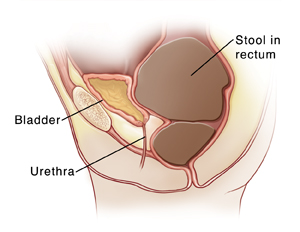When Your Child Has an Elimination Dysfunction
Children often develop an elimination dysfunction during or after they are potty-trained. Your child’s healthcare provider will talk to you about options for treatment.
What is an elimination dysfunction?
It's a problem holding or releasing urine or stool. Infants release (eliminate) urine or stool by reflex. As a child gets older, they learn to control these functions. A child may have a problem learning this control. This is called an elimination dysfunction.
 |
| Constipation can lead to wetting accidents when a too-full rectum pushes against the bladder. |
What causes an elimination dysfunction?
In most cases, this problem occurs because a child holds in urine or stool for too long. Children may put off using the bathroom because they don’t want to stop playing. This puts them at risk for wetting or soiling events. It can also lead to the inability to release stool (constipation).
What are the signs?
Signs of an elimination dysfunction include:
-
Involuntary release of urine (incontinence) during the day or nighttime
-
Constipation
-
Problems with urine flow, such as trouble starting, weak flow, or a lot of starting and stopping
-
Infrequent or frequent release of urine (voiding)
-
Painful urination
-
Urinary tract infection
-
Low-back, belly (abdominal), or side (flank) pain
How is an elimination dysfunction diagnosed?
Your child’s healthcare provider will ask you about your child’s health. A physical exam will also be done to look for problems. To help learn more:
-
You may be asked to keep a record of your child’s bathroom habits.
-
A kidney ultrasound may be done. This checks for blockages in the urinary tract and swelling of the kidneys.
-
A urodynamics study may be done. This tells your healthcare provider how your child’s bladder and urethra work.
How is an elimination dysfunction treated?
Treatment depends on the cause, type, and severity of the problem. Your child may need one or more types of treatment. Common treatments include:
-
Behavioral therapy. This helps your child change their bathroom patterns. It may also include some or all of the following:
-
Emptying the bladder regularly (timed voiding), which helps prevent wetting accidents
-
Positive reinforcement techniques
-
Biofeedback therapy. This helps your child locate the muscles used to control release of stool or urine. They can learn to relax them at the right time.
-
Medicine. This can help relax the bladder, if needed. It can also treat constipation.
-
Intermittent catheterization. This procedure drains the bladder on a regular schedule. A tube (catheter) is put into the urethra and into the bladder. This is done each time it needs to be emptied. This treatment is mainly used in severe cases.
Timed voiding
Timed voiding means urinating at set times. It lets kids who are potty-trained empty their bladders on a regular basis. This helps prevent infections. It also helps to avoid wetting accidents. Your child will need to visit the bathroom at set times throughout the day. Their healthcare provider can suggest how often your child should urinate. When practicing timed voiding, your child should not wait until the urge to urinate arises before using the toilet.
Coping with an elimination dysfunction
This problem can be frustrating for children and families. Be supportive and patient. It takes work and time to create new bathroom habits. Encourage your child’s success. In some cases, a therapist can help kids and their families follow the treatment plan.